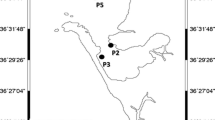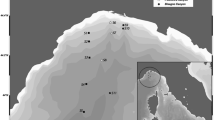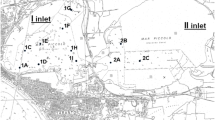Abstract
The toxicological responses of three species to 103 surficial saltwater sediment samples from Sydney Harbour, and coastal lakes and estuaries on the south-east coast of New South Wales, Australia, were tested in a battery of four to six laboratory toxicity tests. This is the first large-scale toxicological study of sediments in Australia, the objective of which is to assess the protective and predictive abilities of North American biological effects-based sediment quality guidelines, recently adopted in Australia. Amphipods were exposed to whole sediments in survival and reburial tests, sea urchin fertilisation and larval development tests were conducted on porewaters, and bacterial bioluminescence (Microtox®) tests were conducted on organic solvent extracts and porewaters. Local indigenous species were used for the amphipod and sea urchin tests (Corophium sp. and Heliocidaris tuberculata, respectively). A wide range of responses, from ≤25 to 100% of negative controls were observed in all tests. Mean control-adjusted responses ranged from 46 to 96% for all tests. The percentages of highly toxic samples ranged from 11 to 83% in the various tests. The order of test sensitivity was: amphipod survival ≤ Microtox® test of porewaters ≤ amphipod reburial ≤ sea urchin larval development ≤ sea urchin fertilisation ≤ Microtox® test of solvent extracts. Concordance between toxicity tests in classifying samples as highly toxic or not, ranged from 47 to 79%, indicating some similarities between test results, but not complete equivalence. Combined toxicity test results showed that the incidence of highly toxic responses occurring in the majority of tests (75–100% of tests) was low (5% of samples), but a large percentage of samples had highly toxic results in at least one test (76% of samples). Toxicity was more pervasive in the Sydney region than in coastal lakes and estuaries south of Sydney. The current study demonstrated the utility of indigenous invertebrate species and the Microtox® bacterium in a sediment toxicity test battery for Australian saltwater sediments.
Similar content being viewed by others
References
ANZECC/ARMCANZ: 2000, ‘Australian and New Zealand Guidelines for Fresh and Marine Water Quality’, Vol. 1, Section 3.5-Sediment Quality Guidelines, Australian and New Zealand Environment and Conservation Council, and Agriculture and Resource Management Council of Australia and New Zealand. Canberra, Australia.
ASTM: 1998a, ‘Standard guide for conducting 10-day static sediment toxicity tests with marine and estuarine amphipods’, ASTM E 1367–92, in 1998 Annual Book of ASTM Standards, Vol. 11.05, pp. 732–757. ASTM, Philadelphia, PA, U.S.A.
ASTM: 1998b, ‘Standard guide for collection, storage, characterization and manipulation of sediments for toxicological testing’, E 1391–94, In 1998 Annual Book of ASTMStandards, Vol. 11.05, pp. 768–788. ASTM, Philadelphia, PA, U.S.A.
AZUR: 1995a, Microtox® Acute Toxicity Basic Test Procedures, AZUR Environmental, Carlsbad, CA, U.S.A., 63 pp.
AZUR: 1995b, Microtox® Acute Toxicity Comparison and Inhibition Test for Fresh Water and Marine Samples, AZUR Environmental, Carlsbad, CA, U.S.A., 29 pp.
Birch, G. F. and Taylor, S. E.: 1999, ‘Source of heavy metals in sediments of the Port Jackson estuary, Australia’, Sci. Total Environ. 227, 123–138.
Birch, G. F. and Taylor, S. E.: 2000, ‘Distribution and possible sources of organochlorine residues in sediments of a large urban estuary, Port Jackson, Sydney’, Aust. J. Earth Sci. 47, 749–756.
Carr, R. S. and Chapman, D. C.: 1995, ‘Comparison of methods for conducting marine and estuarine sediment porewater toxicity tests-Extraction, storage, and handling techniques’, Arch. Environ. Contam. Toxicol. 28, 69–77.
Carr, S. R.: 2001, Toxicity Testing of Sediments from BEST/EMAP Western Coastal Monitoring Study, USGS Biomonitoring of Environmental Status and Trends Program, U.S. Geological Survey, 11 pp.
Carr, R. S., Long, E. R., Windom, H. L., Chapman, D. C., Thursby, G., Sloane, G. M. and Wolfe, D. A.: 1996, ‘Sediment quality assessment studies of Tampa Bay, Florida’, Environ. Toxicol. Chem. 15(7), 1218–1231.
Chapman, P. M.: 1995, ‘Do sediment toxicity tests require field validation?’, Environ. Toxicol. Chem. 14, 1451–1453.
Chapman, P. M., Dexter, R. N. and Long, E. R.: 1987, ‘Synoptic measures of sediment contamination, toxicity and infaunal community composition (the Sediment Quality Triad) in San Francisco Bay’, Mar. Ecol. Prog. Ser. 37, 75–96.
Hyland, J. L., Snoots, T. R. and Balthis, W. L.: 1998, ‘Sediment quality of estuaries in the Southeastern U.S.’, Environ. Monit. Assess. 51, 331–343.
Hyne, R. V. and Everett, D. A.: 1998, ‘Application of a benthic euryhaline amphipod, Corophium sp., as a sediment toxicity testing organism for both freshwater and estuarine systems’, Arch. Environ. Contam. Toxicol. 34, 26–33.
Ingersoll, C. G. et al.: 1997, ‘Workgroup Summary Report on Uncertainty Evaluation of Measurement Endpoints used in Sediment Ecological Risk Assessments’, in C. G. Ingersoll, T. Dillon and G. R. Biddinger (eds), Ecological Risk Assessment of Contaminated Sediments, SETAC Special Publication, Society of Environmental Toxicology and Chemistry, Pensacola, FL, pp. 271–296.
Johnson, B. T. and Long, E. R.: 1998, ‘Rapid toxicity assessment of sediments from estuarine ecosystems: A new tandem in vitro testing approach’, Environ. Toxicol. Chem. 17(6), 1099–1106.
Long, E. R. and Chapman, P. M.: 1985, ‘A sediment quality triad: Measures of sediment contamination, toxicity and infaunal community composition in Puget Sound’, Mar. Pollut. Bull. 16(10), 405–415.
Long, E. R., Buchman, M. F, Bay, S. M., Breteler, R. J., Carr, R. S., Chapman, P. M., Hose, J. E., Lissner, A. L., Scott, J. and Wolfe, D. A.: 1990, ‘A comparative evaluation of five toxicity tests with sediments from San Francisco Bay and Tomales Bay, California’, Environ. Toxicol. Chem. 9, 1193–1214.
Long, E. R., Robertson, A., Wolfe, D. A., Hameedi, J. and Sloane, G. M.: 1996, ‘Estimates of the spatial extent of sediment toxicity in major U.S. estuaries’, Environ. Sci. Technol. 30(12), 3585–3592.
Long, E. R., Sloane, G. M., Carr, R. S., Johnson, T., Biedenbach, J., Scott, K. J., Thursby, G. B., Crecelius, E., Peven, C., Windom, H. L., Smith, R. D. and Loganathon, B.: 1997, ‘Magnitude and extent of sediment toxicity in four bays of the Florida Panhandle: Pensacola, Choctawhatchee, St. Andrew and Apalachicola’, NOAA Technical Memorandum NOS ORCA 117, U.S. National Oceanic and Atmospheric Administration, Silver Spring, Maryland, 219 pp.
Long, E. R., Field, L. J. and MacDonald, D. D.: 1998, ‘Predicting toxicity in marine sediments with numerical sediment quality guidelines’, Environ. Toxicol. Chem. 17(4), 714–727.
Long, E. R., Hameedi, J., Robertson, A., Dutch, M., Aasen, S., Ricci, C., Welch, K., Kammin, W., Carr, R. S., Johnson, T., Biedenbach, J., Scott, K. J., Mueller, C. and Anderson, J.: 1999, ‘sediment quality in Puget Sound. Year 1 Report-northern Puget Sound’, National Oceanic and Atmospheric Administration (NOAA) Technical Memorandum NOS NCCOS CCMA No. 139 and Washington State Dept. of Ecology Publication No. 99–347, Washington, U.S.A.
Long, E. R.: 2000, ‘Spatial extent of sediment toxicity in U.S. estuaries and marine bays’, Environ. Monit. Assess. 64, 391–407.
Long, E. R., MacDonald, D. D., Severn, C. G. and Hong, C. B.: 2000, ‘Classifying probabilities of acute toxicity in marine sediments with empirically derived sediment quality guidelines’, Environ. Toxicol. Chem. 19(10), 2598–2601.
Long, E. R., Hong, C. B. and Severn, C. G.: 2001, ‘Relationships between acute sediment toxicity in laboratory tests and abundance and diversity of benthic infauna in marine sediments: A review’, Environ. Toxicol. Chem. 20(1), 46–60.
Long, E. R.: 2002, ‘Toxicity Tests of Marine and Estuarine Sediment Quality: Applications in Regional Assessments and Uses of the Data’, Chapter 6, in R. C. Whittemore (ed.), Handbook on Sediment Quality, Water Environment Federation, Alexandria, Virginia, U.S.A., pp. 259–316.
Matthiessen, P., Bifield, S., Jarrett, F., Kirby, M. F., Law, R. J., McMinn, W. R., Sheahan, D. A., Thain, J. E. and Whale, G. F.: 1998, ‘An assessment of sediment toxicity in the River Tyne estuary, U.K. by means of bioassays’ Mar. Environ. Res. 45(1), 1–15.
McCready, S., Slee, D. J., Birch, G. F. and Taylor, S. E.: 2000, ‘The distribution of polycyclic aromatic hydrocarbons in surficial sediments of Sydney Harbour, Australia’, Mar. Pollut. Bull. 40(11), 999–1006.
Mondon, J. A.: 2000, ‘Ecotoxicology of Contaminated Marine Sediments in Tasmaniane Estuaries’, Ph.D. Thesis, University of Tasmania, Australia, 209 pp.
PSDDA: 2000, Dredged Material Evaluation and Disposal Procedures. A Users Manual for the Puget Sound Dredged Disposal Analysis (PSDDA) Program, Seattle District, Army Corps of Engineers; U.S. Environmental Protection Agency; Washington Department of Natural Resources; Washington Department of Ecology.
Ross, P. E.: 1993, ‘The Use of Bacterial Luminescence Systems in Aquatic Toxicity Testing’, in M. Richardson (ed.), Ecotoxicology Monitoring, VCH Publishers, New York, NY, U.S.A., pp. 185–195.
Simon, J. and Laginestra, E.: 1997, ‘Bioassay for Testing Sublethal Toxicity in Effluents, Using Gametes of Sea Urchin Heliocidaris tuberculata’, National Pulp Mills Research Program Technical Report No. 20, Canberra: CSIRO, Australia, 36 pp.
Spyrakis, G.: 2002, ‘Assessment of the Predictive Ability of Sediment Quality Guidelines Using Sea Urchin Toxicity Tests’, M.Sc. Thesis, School of Geosciences, The University of Sydney, NSW, Australia.
Surtikanti, H. K., Hyne, R. V., Everett, D. A. and Lim, R. P.: 1998, ‘Population density and breeding periodicity of the amphipod, Corophium sp., in the Hawkesbury River’, Australas. J. Ecotox. 4, 85–91.
Surtikanti, H. K.: 2001, ‘Ecotoxicological Studies on the Benthos in the Freshwater Section of the Hawkesbury-Nepean River Catchment’, Ph.D. Thesis, University of Technology, Sydney, Australia, 213 pp.
Swartz, R. C., DeBen, W. A., Sercu, K. A. and Lamberson, J. O.: 1982, ‘Sediment toxicity and the distribution of amphipods in Commencement Bay, Washington, U.S.A.’, Mar. Pollut. Bull. 13, 359–364.
Tay, K.-L., Doe, K. G., Wade, S. J., Vaughan, D. A., Berrigan, R. E. and Moore, M. J.: 1992, ‘Sediment bioassessment in Halifax Harbour’, Environ. Toxicol. Chem. 11, 1567–1581.
Thursby, G. B., Heltshe, J. and Scott, K. J.: 1997, ‘Revised approach to toxicity test acceptability criteria using a statistical performance assessment’, Environ. Toxicol. Chem. 16(6), 1322–1329.
ToxCalcTM: 1996, Version 5.0 User's Guide, Tidepool Scientific Software, McKinleyville, CA, U.S.A.
U.S. EPA/U.S. ACOE: 1991, ‘Evaluation of dredged material proposed for ocean disposal’, Testing manual, EPA-503/8–91/001, U.S. Environmental Protection Agency and U.S. Army Corps of Engineers, U.S. EPA, Washington, DC.
U.S. EPA: 1997, The Incidence and Severity of Sediment Contamination in Surface Waters of the United States, Vol. 1, National sediment quality survey, EPA 823-R–97–006, U.S. Environmental Protection Agency, Washington, D.C.
Williams, L. G., Chapman, P. M. and Ginn, T. C.: 1986, ‘A comparative evaluation of marine sediment toxicity using bacterial luminescence, oyster embryo and amphipod sediment bioassays’, Mar. Environ. Res. 19, 225–249.
Author information
Authors and Affiliations
Corresponding author
Rights and permissions
About this article
Cite this article
McCready, S., Spyrakis, G., Greely, C.R. et al. Toxicity of Surficial Sediments from Sydney Harbour and Vicinity, Australia. Environ Monit Assess 96, 53–83 (2004). https://doi.org/10.1023/B:EMAS.0000031716.34645.71
Issue Date:
DOI: https://doi.org/10.1023/B:EMAS.0000031716.34645.71




